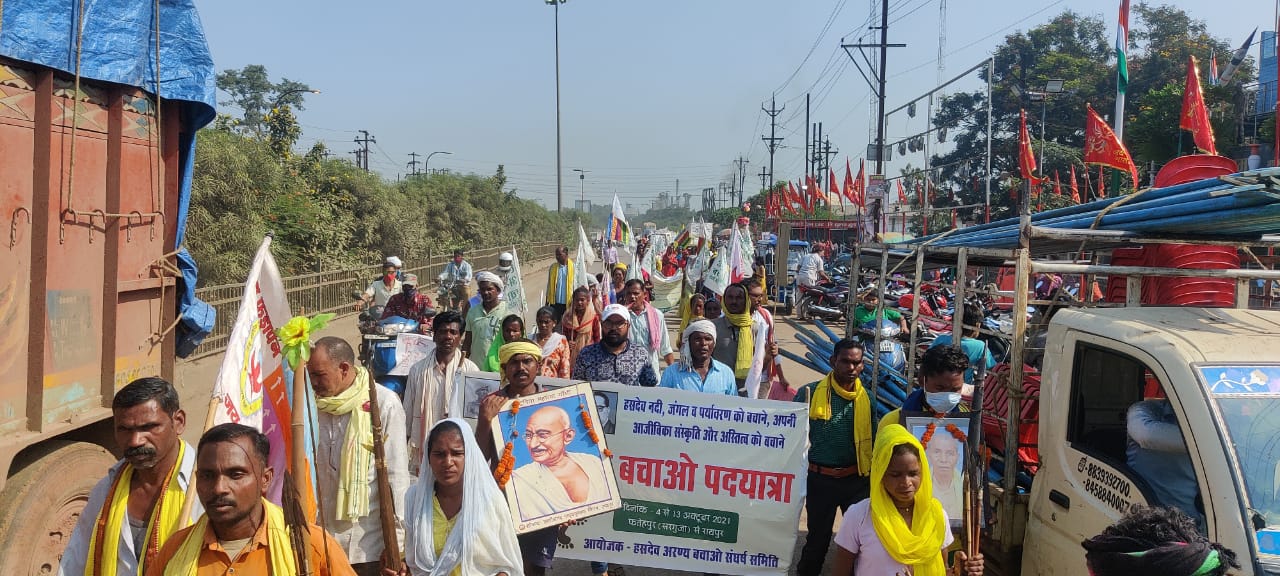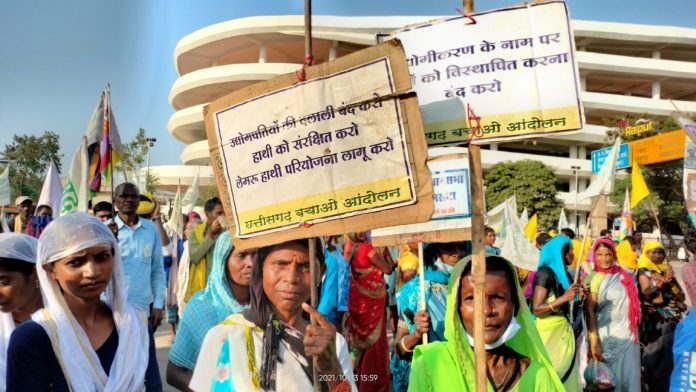Nearly 350 residents from the villages of central Chhattisgarh are on a 300-km long march that started on October 2 to reach the capital of Chhattisgarh, Raipur and meet with the state authorities. The TCN Ground Report looks at what is going on at Hasdeo Arand and why Adivasis are marching to protect it.
Nikita D | TwoCircles.net
CHATTISGARH – Hasdeo Arand is a large forest corridor that spans across north Chhattisgarh’s Korba and Sarguja districts and covers an area of 1500 km approximately. One of the largest areas of intact forest in the country, the location is a vivacious natural spot for perennial rivers, rare plant life, and animals including leopards and elephants.
According to the mapping done by the Ministry of Coal, the area holds the potential of a billion metric tonnes of coal across an area of 1878 square kilometres, out of which 1502 square kilometres is a forested cover.
The forests have been home to several Adivasi communities including the Gond, Oraon, Lohar, and Kunwar. Due to the topography of the region, these communities have centred their livelihoods and culture around the forest that includes living off agriculture and forest produce.
Given the large possibilities of coal extraction and the growing demands for cheap fossil fuel, of which India is the second-largest producer in the world, the region has been a seat of contestation between people and parties alike, for over a decade.
A history of the dispute
Several scientific field research commissioned by the state as well as people-centric advocacy have suggested against mining in the area that will cause irreparable damage to the pristine location, ecological equilibrium possible due to its preservation, and to the communities living there for many generations.
In 2010, the then Environment Minister Jairam Ramesh had declared Hasdeo Arand a ‘no-go area’, meaning that the area was off-limits for mining or any kind of infrastructural projects that would cause altercations to the landscape.
However, one year later in 2011, the same minister bypassed the mandate and granted a stage-1 forest clearance to three blocks in the region: Tara, Parsa East, and Kante Basan. Justifying his decision to open mines in the densely forested region, he said that the locations chosen were on the fringes of the forest and were outside the central biodiverse region. He vowed that these three would be the first and the last time that clearance would be given to projects in Hasdeo Arand.
This was despite the recommendations of the Union Ministry of Environment, Forest and Climate Change (MoEFCC) that had reported against mining activity in the area given the ecological value and the high number of trees that would need to be felled to make open cast mines (OCMs).
A National Green Tribunal (NGT) in 2014 ordered probing into the matter and the Indian Council of Forestry Research and Education (ICFRE) was set up for that purpose. This response came after lawyer-activist Sudiep Shrivastava petitioned to the tribunal challenging the clearance given to the Rajasthan Rajya Vidyut Utpadan Nigam Limited (RRVUNL), Rajasthan’s state power company, for opening mines in the forest area.
The ICFRE did not begin work till 2019 and submitted its report in February 2021. The report noted that “forest fragmentation will contribute to decreased patch/corridor connectivity, increased edge effect, change in micro-climate and promote invasive species if not taken adequate mitigation measures.”
However, while admitting the irrevocable damage that mining would do to the biodiversity of the area and subsequently to the livelihood of the residents, the report said that four contiguous coal blocks, Tara, Parsa, PEKB, and Kente Extension, that are “either already opened or in advance stage of getting the statutory clearances/Terms of Reference approved, can be considered for mining with strict environmental safeguards including appropriate conservation measures for the management of surface water and biodiversity.”
This was challenged by activists in the region who questioned the authority of the ICFRE to make such recommendations.
Commenting on the contradictory nature of the report, Convenor of Chhattisgarh Bachao Andolan, Alok Shukla said, “It is evident that the report was made under pressure from Adani Group.”
Governmental oversights and bypassing protective laws
Hasdeo Arand region comes under Schedule 5 Areas of the Indian Constitution. Schedule 5 Areas are regions with high Adivasi populations who have a history of sustaining the land and the environment through independent and self-sufficient means of sustenance different from modern economic systems. The Constitution guarantees safeguarding the plurality of existences despite the growth of modern infrastructural development schemes. Acts such as Panchayats (Extension to Scheduled Areas) Act 1996, PESA, that apply to Schedule 5 Areas guarantee that any decision to open up infrastructural projects in Schedule 5 Areas have to be sanctioned by the gram sabhas of the region, which are comprised of all the residents of each village.
However, the state has chosen to manoeuvre and bend these protective laws in favour of mining by evoking the Coal Bearing Areas Act 1957, which allegedly overrides laws like PESA in coal-rich regions.
“The land acquisition of Parsa coal block happened through Coal Bearing Areas Act. The government says that PESA does not apply when acquiring land through that Act. But no law can override the separate laws for Scheduled areas. Moreover, they should use Land Acquisition Act of 2013 instead of using a law from 1957,” Alok Shukla told TwoCorcles.net.
Shukla said that in 2019, a 75-day strike was held in Hasdeo Arand to contest the alleged permission given by the gram sabhas as part of the second stage of forest clearance. “The villagers had said that either permission was forged or was taken by coercing the sarpanch to sign. The people had appealed to the government to investigate the matter. But no such investigation happened,” Shukla said.
The monopoly of coal mines is single-handedly enjoyed by Adani Group, whose owner, Gautam Adani, is the second richest person in India. Adani Mining Pvt. Ltd. holds 74% of the stakes in RRVUNL, making it the biggest stakeholder in the company. By 2013, the Adani group had begun construction in the Parsa East-Kente Basan (PEKB) mine in Hasdeo.
In fact, out of the four sanctioned blocks, three of them, under state-owned corporations, have awarded MDO (mine developer and operator) contracts to Gautam Adani’s private company Adani Enterprises Limited (AEL).
Adani group, one of the largest companies in India, was reported to have an increased net worth of 230% since the Modi government came to power.
The coal empire had recently come under scrutiny when a campaign was launched in Queensland, Australia by indigenous and environmental activists against its Carmichael coal mine.
Global criticism has followed the decision of the Modi government to ramp up coal production in India after it promised to invest in renewable sources of energy at the 2015 Paris Climate Summit. The Centre estimated 175 GW of power generation through renewable energy by 2022, but nearly 70% of India’s electricity is still powered by coal, a non-renewable fossil fuel.
Talking to TwoCircles.net, Jo Woodman of Survival International, a UK-based international human rights organization, said, “India has a growing economy and population, it needs energy and currently the majority of that energy comes from coal. But that cannot be India’s future. As the UN Secretary-General has said, all nations need to urgently end their “deadly addiction” to coal. Coal mining, especially at the expense of indigenous lives and lands and rich forests, is a clear and obvious disaster for all our futures. It is not in the interests of the citizens of India for their Prime Minister to be pushing to mine one billion tonnes of coal a year.”
People’s struggle
Most recently, land acquisition of Parsa coal block took place through the Coal Bearing Areas Act (CBA), 1957. Shukla informs that construction for mining began after the Consent to Establish Certificate was issued to the company post the Environment Clearance in 2019.
The people of Hasdeo Arand have been objecting, for the past one month, after construction activities started without the gram sabha permission.
“In three villages where there is opposition against the construction, the company has settled 10 families and have compensated them. They started construction on those lands. But you cannot start a project without taking the permission of the entire village first,” Shukla said.
Nearly, 350 residents from the villages of central Chhattisgarh are on a 300-km long march that started on October 2 to reach the capital of Chhattisgarh, Raipur and meet with the state authorities.

The operational OCMs in Chhattisgarh stretch across gigantic areas where one can only see coal mines as far as the sight goes. They have significantly debilitated the lives of those whose land it took over for construction.
To understand what is at stake for the people, TwoCircles.net asked Shukla, who has been working closely with the communities for a decade and was on the march when the conversation took place. “I will tell you an anecdote to explain the intensity of the situation. During the yatra (march), the people were feeling tired after walking 1 km on the open road. They can walk miles in the forest and feel nothing. This is because they are so used to the forest cover,” he said, adding, “A woman from the village was saying that eight generations of her family have lived in the forest. She is now worried about her children. People outside do not understand the generational security we are talking about.”
Shukla further said that even after rehabilitation happened in KP Extension, “more than 50% people are landless and no longer have the settled money.”
“The government thinks that giving people a 10x10sq ft. 2-bedroom flat and a job with 7000 rupees monthly salary is fair compensation,” he said, and added, “But this is an estranged life for them. Living off forest produce and agriculture, the people have big houses, they consume 1.5 litres of milk every day and get their vegetables from the forest.
Purchasing that kind of produce from the market will cost them at least 5000 rupees per month. With no formal education, there is no chance of them getting high-salaried jobs.”
Commenting on global reverberations of the struggle against extractive policies, Woodman informed TwoCircles.net, “If we look across the world right now, it is the indigenous peoples who are keeping the forests standing and the coal and oil in the ground. Right now, while the Adivasi resistance from Hasdeo Forest is arriving in Raipur, in Washington DC, indigenous land defenders are standing in front of the White House demanding an urgent end to fossil fuel extraction and burning. Indigenous peoples are the worst affected by climate change, from the Arctic to the Amazon, and are at the frontlines of protecting the biodiversity and climate on this planet. We should be seeking their leadership at this time, not trampling on their rights, imprisoning their leaders, and grabbing their lands”.
According to the notice issued by Hasdeo Aranya Bachao Sangharsh Samiti, the demands of those marching to the capital include cancelling all coal mining projects in Hasdeo Aranya, implementation of mandatory consent required from gram sabha in Schedule 5 Areas, and recognition of community forest resources and individual forest rights in each village.


